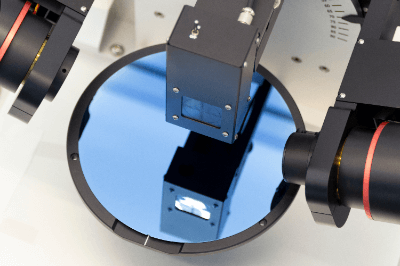What Is an Ellipsometer?

An Ellipsometer is a non-contact, non-destructive instrument for measuring the thickness of a thin film or the optical constant of a material using its optical properties.
It is also called an ellipsoid polarization analyzer. The Ellipsometer measures the optical constant of an object by shining light from an oblique angle onto the object, receiving the reflected light with a sensor, and measuring the change in polarization state.
Although commonly referred to as an ellipsometer, the correct term is spectroscopic ellipsometer. Measurements cannot be made on opaque films that do not transmit light or on rough surfaces that do not reflect light sufficiently.
Uses of Ellipsometers
Ellipsometers are primarily used to measure optical constants and, based on these constants, to measure film thickness. Since ellipsometers measure reflected polarized light, they cannot measure very thick objects (1 mm or less).
However, some instruments have a resolution of 0.01nm scale for thin films, so they are often used to measure the thickness of thin films with high accuracy. The optical properties of optical films such as various coatings and lenses can be measured, as well as the crystallinity, composition, and optical anisotropy of the materials that make up the film.
Depending on the instrument, it is also possible to measure the optical properties of liquids.
Principle of Ellipsometer
Light projected at an oblique angle from a light source is shined onto the object (film) to be measured, and the reflected light is received by a light-receiving sensor to measure the change in polarization. Since the projected light is known, the difference from the received light is measured at each wavelength for fitting analysis.
Ellipsometers are available in two main types of light sources: single wavelength laser light sources and spectroscopic xenon lamp light sources. The former can only measure a limited number of wavelengths because it only measures a single wavelength, but its advantage is that it is inexpensive.
The latter can perform more detailed measurements, such as analysis of multilayer films and measurement of the boundary (interface) between films. However, it has disadvantages such as light source calibration and higher equipment cost. The Ellipsometer is also equipped with an autocollimator that measures whether the object is installed horizontally.
The angle of incidence from the light source is also very important. Therefore, the data from the autocollimator is compared with the angle of the light source (fixed value) and used for analysis.
How to Select an Ellipsometer
1. Appropriate Wavelength Range for the Measurement Purpose
Ellipsometers measure different properties depending on the wavelength of light. It is important to select an ellipsometer with an appropriate wavelength range according to the properties and purpose of the material to be measured.
Most ellipsometers cover the wavelength range from general visible light to near-infrared light, but some applications may require a wider wavelength range.
2. Measurement Accuracy and Sensitivity
The measurement accuracy and sensitivity of ellipsometers are important factors. Selecting an ellipsometer with high accuracy and sensitivity will enable more accurate measurement of optical properties and thickness of thin films. Especially in fields such as research and manufacturing process control, highly accurate measurements are required.
3. Automation and Ease of Use
Check to see if the Ellipsometer is easy to operate and automated. If it is automated, many measurements can be made quickly, allowing for efficient data collection. Selecting an ellipsometer with an easy-to-use interface and software will also ensure smooth operation.
4. Adaptability to Sample Size and Shape
It is important to select the appropriate measurement device according to the size and shape of the sample you wish to measure. In general, an Ellipsometer that can handle large samples and samples with special shapes is required. In addition, a non-contact Ellipsometer capable of non-destructive measurement should be considered as an option.